The cost of installing and operating a sprinkler irrigation system can vary depending on factors such as the size of the area to be irrigated, the type of crops grown, local climate conditions, water source availability, and the specific design and technology chosen for the system. However, in general, sprinkler irrigation systems tend to have both advantages and disadvantages in terms of cost compared to other irrigation methods such as surface irrigation (furrow or flood irrigation) or drip irrigation.
Installation Costs:
- Sprinkler Irrigation: The installation of a sprinkler irrigation system typically involves the installation of pipes, sprinkler heads, pumps, valves, controllers, and possibly filtration systems. The initial investment can be relatively high due to the cost of equipment and labor for installation.
- Surface Irrigation: Surface irrigation methods like furrow or flood irrigation may require less initial investment in equipment since they primarily rely on natural or gravity-fed water distribution. However, they may require more labor-intensive preparation of fields and maintenance of irrigation channels.
- Drip Irrigation: Drip irrigation systems generally have higher initial installation costs compared to sprinkler systems due to the need for specialized tubing, sprinkler irrigation system emitters, filters, and pressure regulators. However, they may be more cost-effective for certain crops or in areas with limited water availability due to their potential water savings.
Operating Costs:
- Sprinkler Irrigation: The operating costs of sprinkler irrigation systems include energy costs for running pumps, maintenance costs for equipment such as sprinkler heads and valves, as well as water costs if using municipal or groundwater sources. However, they may require less labor for operation compared to surface irrigation methods.
- Surface Irrigation: Surface irrigation methods may have lower operating costs since they generally do not require energy for water distribution, relying instead on gravity or natural water flow. However, they may have higher water usage and may be less efficient in terms of water distribution uniformity.
- Drip Irrigation: Drip irrigation systems often have lower operating costs compared to sprinkler systems since they typically use less water due to targeted application directly to the root zone of plants. However, they may require more frequent maintenance to prevent clogging of emitters and filters.
Overall Comparison:
- The choice of irrigation method depends on various factors including the specific requirements of the crop, soil conditions, water availability, labor availability, and budget constraints.
- While sprinkler irrigation systems may have higher initial installation costs compared to some surface irrigation methods, they offer advantages in terms of flexibility, water efficiency, and potential labor savings.
- Drip irrigation systems are generally more water-efficient but may have higher initial installation costs and require more maintenance compared to sprinkler systems.
- Ultimately, the most cost-effective irrigation method will vary depending on the specific circumstances and goals of the farming operation.


